VANILLA RLC
Installing Your Fork | Before You Ride | Setting Sag | Adjusting Rebound | Locking Out the Fork | Adjusting Lockout Force | Adjusting Low-Speed Compression | Changing the Coil Spring | Service Intervals | Important Safety Information
|
|
weight |
4.17 lbs./1.89 kg |
|
travel The total amount the shock or fork compresses. On a shock it is measured using the eye-to-eye distance or shaft travel. |
5.5 in. / 140 mm | |
|
features/adjustments |
low-speed compression, lockout, lockout force adjust, coil spring preload Initial force placed on an air or coil spring., rebound | |
|
spring/damper type |
steel spring/open bath | |
|
intended use |
all-mountain A style of bicycle riding that melds the stamina and conditioning required of cross-country with the technical abilities of freeriding., freeride A style of riding that is defined by short course technical acrobatics and athletes that defy gravity. Generally, the bikes and components required for freeriding are stronger and heavier than their lightweight cross-country brethren. Combine the aerial pyrotechnics of freeriding with some longer trails and courses, as is typical of cross-country riding, and now you're looking at all-mountain riding. | |
|
color |
Black Diamond |
Be sure your fork is properly installed before proceeding. Clicking on the link above will take you to a new page.
Check that quick-release levers are properly adjusted and tightened.
Clean the outside of your fork with soap and water and wipe dry with a soft dry rag. Do not spray water directly on the seal/upper tube junction. Do not use a high pressure washer on your fork.
Inspect entire exterior of fork for damage. The fork should not be used if any of the exterior parts appear to be damaged. Please contact your local dealer or FOX Racing Shox for further inspection and repair.
Check headset adjustment. If loose, adjust according to manufacturer’s recommendations.
Check that brake cables or hoses are properly fastened.
Check that the front and rear brakes operate properly on flat land.
You can also view a Flash video on Setting Sag.
To get the best performance from your fork, it is necessary to set and adjust sag Amount a shock or fork compresses with the rider sitting on the bike in a normal riding position. Best measured with an assistant holding your bike up and with the rider in full riding gear. On a fork, it is helpful to place a ZIP tie around one of the upper tubes.. Generally, sag should be set to 15 – 25% of total fork travel.
Install a zip tie with light friction on the upper tube and push it down until it contacts the fork seal.
Carefully sit on the bike and assume a normal riding position. The fork should compress slightly.
Being careful not to further compress the fork, dismount the bicycle. Measure the distance between the seal and the zip tie. This distance is sag.
Compare your sag measurement
to the Sag Setup table below.
If sag is lower than in the table, turn the preload knob (shown
below) counter-clockwise one (1) full turn. Measure sag again and repeat
adjustment if necessary.
If sag is higher than in the table, turn the preload knob clockwise A motion that proceeds from the top to the right, then down and then
to the left, and back to the top, like the clock's hands.
one (1) full turn. Measure sag again and repeat adjustment if necessary.
If correct sag cannot be achieved by adjusting the preload knob, see the
Vanilla Coil Spring Settings table
below. You may need to change
to a coil spring with a different spring rate Force required to compress a spring one inch..
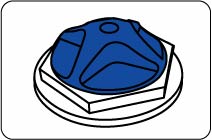
|
FOX Part # |
Approximate Spring Rate |
Color Code |
Travel (mm) |
Rider Weight |
|
039-05-080 |
40.6 lb/in |
Black |
140 |
<90–115 |
|
039-05-081 |
48.5 lb/in |
Purple |
140 |
115–150 |
|
039-05-082 |
56.4 lb/in |
Blue |
140 |
150–180 |
|
039-05-083 |
60.9 lb/in |
Green |
140 |
180–210 |
|
Symptom |
Remedy |
|
Too much sag |
Change to higher rate coil spring |
|
Too little sag |
Change to lower rate coil spring |
|
Excessive bottoming |
Change to higher rate coil spring |
|
Harsh ride; full travel not utilized |
Change to lower rate coil spring |
The rebound knob (shown below) is located on the top of the right fork leg, and has 12 clicks of adjustment. Rebound controls the speed at which the fork extends after compressing. Turning the knob clockwise A motion that proceeds from the top to the right, then down and then to the left, and back to the top, like the clock's hands. slows down rebound; turning the knob counterclockwise speeds up rebound. As a starting point, turn the rebound adjuster knob all the way clockwise (full in) until it stops, then turn counterclockwise (out) 6 clicks.
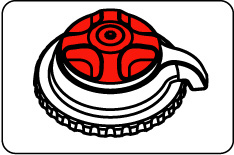
|
Knob Setting |
Setting Description |
Tuning Tips |
Setup Tips |
|
|
Slow Rebound |
Too slow and your fork will pack down and ride harsh. |
If you increase your spring rate or air pressure, you will need to slow down your rebound |
|
6 (Factory setting) |
Average Rebound |
|
|
|
|
Fast Rebound |
Too fast and you will experience poor traction and wheel hop. |
If you decrease your spring rate or air pressure, you will need to speed up your rebound setting. |
The blue compression lockout lever is located below the red rebound adjuster knob. It allows the rider to close the compression damping circuit in the fork. This keeps the fork at the top of its travel, making it harder to compress.
Rotate the lever fully clockwise to lockout the fork. This position is useful in climbing and sprinting situations, but will sag with the rider’s weight. The fork will "blowoff" in the event that a big hit is encountered with the fork locked out.
To unlock the fork, simply rotate the lever fully counterclockwise.
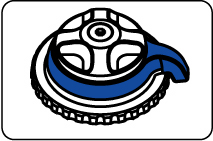
The fork may cycle a couple of times after enabling lockout. Once complete lockout is achieved, the fork may continue to move 3 - 5 mm. This is normal and does not affect performance.
Even when your fork is fully locked out, there are instances when you still want your fork to be active. To protect your fork's internal parts, your FOX fork will "blowoff" when it encounters an intense hit. You can adjust when the fork blows off—lockout force—by adjusting the blue knob on the bottom of the right leg.
A convenient tuning feature of the lockout force knob is that it allows you to leave your fork in the locked out position—no more fiddling with fork controls when the trail requires your undivided attention. Although you might need to adjust the knob a few times to find the sweet spot, once it is found you can simply leave your fork locked out. Your fork will then respond to hits in the trail (greater lockout force), for example, but will be locked out (lower lockout force) when you are out of your saddle on a climb.
Turn the knob clockwise to increase lockout force and counterclockwise to decrease lockout force.
There are 12 clicks of adjustment. As a starting point, turn the knob all the way clockwise until it stops, then back off one click counterclockwise.
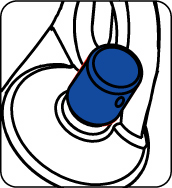
Low-speed compression damping is adjusted with the blue bezel ring (shown below) below the blue lockout lever, and has 8 clicks of adjustment. Compression damping controls the speed at which the fork compresses. Adjust low-speed compression with lockout disabled (lockout lever fully counterclockwise). As a starting point, turn the low-speed compression dial all the way counterclockwise (full out) until it stops, then turn clockwise (in) 5 clicks.
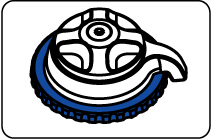
|
Knob Setting |
Setting Description |
Tuning Tips |
Setup Tips |
|
|
Soft Compression |
Too soft and your fork will pack down and ride harsh. |
Maximum wheel traction and bump compliance. Too soft and you maybe have excessive brake dive and wallowy feel. |
|
5 |
Average Compression |
|
|
|
|
Firm Compression |
Too firm and you will experience poor traction and wheel hop. |
Resists brake dive and keeps the fork up in the travel. Too firm and you may have poor traction in loose conditions. |
With a 26mm 6-point socket wrench, loosen and remove the preload topcap (top of left leg).
Compress the fork slightly and remove the coil spring. You may need to firmly pull up on the spring to disengage it from the plunger shaft.
Wipe the spring dry with a rag and check the color code.
Install the new spring by dropping it into the upper tube.
Torque the topcap to 165 in-lb. (1864 N-cm).
Rotate the fork to a horizontal position and shake it to move the oil inside the fork over the spring. This lubricates it before its first travel push.
eng026